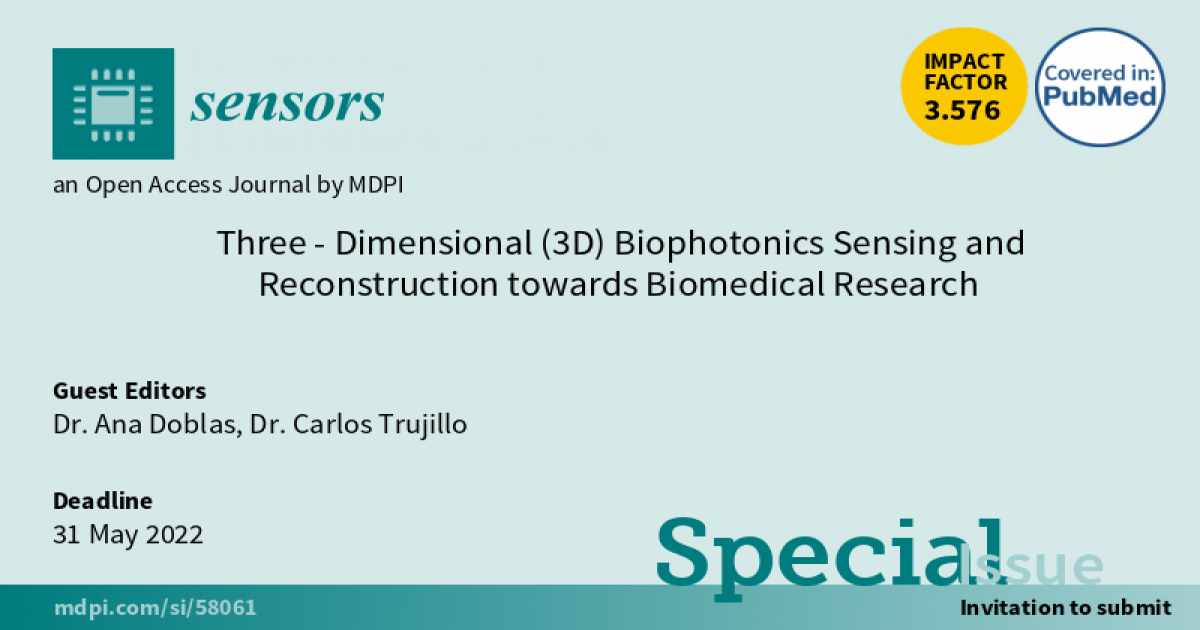Three-Dimensional (3D) Biophotonics Sensing and Reconstruction towards Biomedical Research
A special issue of Sensors (ISSN 1424-8220). This special issue belongs to the section "Sensing and Imaging".
Deadline for manuscript submissions: closed (31 May 2022) | Viewed by 18708

Special Issue Editors
Interests: biomedical systems; optical imaging systems for microscopy; multidimensional imaging techniques; computational imaging for microscopy
Special Issues, Collections and Topics in MDPI journals
Interests: optical systems; deep learning techniques; computational imaging strategies
Special Issues, Collections and Topics in MDPI journals
Special Issue Information
Dear Colleagues,
The purpose of emerging biophotonics sensors, including simultaneous hardware and software development, is to enable the observation of biological cells, organisms, and systems with a high sensitivity, accuracy, and spatial and temporal resolutions. Such achievements have unraveled novel dynamics and mechanism of biological systems, hence encouraging the scientific community to advance the design and implementation of novel three-dimensional imaging sensing and reconstruction methods. This Special Feature calls for innovative and original contributions in the development of imaging sensing and reconstruction approaches that extend the capabilities of existing techniques in terms of spatial resolution, imaging depth, imaging speed, or any other feature relevant for biomedical research.
Topics of interest include, but are not limited to, the following:
- Development and performance of new detectors.
- Development and performance of new sources and light-shaping devices.
- Development and performance of novel three-dimensional imaging sensing systems.
- Investigation of new features and applications using imaging reconstruction post-processing technologies.
- Development and performance of new computational imaging approaches, for instance, compressive sensing and machine learning techniques, including different and adapted versions of deep neural network (DNN) strategies.
Dr. Ana Doblas
Dr. Carlos Trujillo
Guest Editors
Manuscript Submission Information
Manuscripts should be submitted online at www.mdpi.com by registering and logging in to this website. Once you are registered, click here to go to the submission form. Manuscripts can be submitted until the deadline. All submissions that pass pre-check are peer-reviewed. Accepted papers will be published continuously in the journal (as soon as accepted) and will be listed together on the special issue website. Research articles, review articles as well as short communications are invited. For planned papers, a title and short abstract (about 100 words) can be sent to the Editorial Office for announcement on this website.
Submitted manuscripts should not have been published previously, nor be under consideration for publication elsewhere (except conference proceedings papers). All manuscripts are thoroughly refereed through a single-blind peer-review process. A guide for authors and other relevant information for submission of manuscripts is available on the Instructions for Authors page. Sensors is an international peer-reviewed open access semimonthly journal published by MDPI.
Please visit the Instructions for Authors page before submitting a manuscript. The Article Processing Charge (APC) for publication in this open access journal is 2600 CHF (Swiss Francs). Submitted papers should be well formatted and use good English. Authors may use MDPI's English editing service prior to publication or during author revisions.
Keywords
- physical sensors
- biosensors
- lab-on-a-chip
- sensor devices
- sensor technology and application
- signal processing
- deep learning in sensor systems
- sensing systems
Benefits of Publishing in a Special Issue
- Ease of navigation: Grouping papers by topic helps scholars navigate broad scope journals more efficiently.
- Greater discoverability: Special Issues support the reach and impact of scientific research. Articles in Special Issues are more discoverable and cited more frequently.
- Expansion of research network: Special Issues facilitate connections among authors, fostering scientific collaborations.
- External promotion: Articles in Special Issues are often promoted through the journal's social media, increasing their visibility.
- e-Book format: Special Issues with more than 10 articles can be published as dedicated e-books, ensuring wide and rapid dissemination.
Further information on MDPI's Special Issue polices can be found here.







